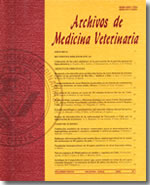Clinical findings in dogs parasited by Dipetalonema dracunculoides
Main Article Content
Abstract
A hundred positive dogs with Dipetalonema dracunculoides were studied. The dogs were naturally infected in the Murcia Region, Spain. The fresh exam (thick drop) and the modified Knott test were used to diagnose microfilarias in blood. To identify the filarial species the acid phosphate activity test was used. Eight percent of the animals showed clinical signs. From these, 4% showed ataxy and incoordination, and 4% showed skin ulceration lesions with alopecia, erythema and pruritus. These findings show the importance to consider the nervous signs and skin lesions in the clinical diagnosis of filariosis caused by D. dracunculoides.
Article Details
How to Cite
BOLIO, M. E., MONTES, A. M., GUTIERREZ, C., ALONSO, F. D., BERNAL, L., SAURI, C. H., & RODRIGUEZ-VIVAS, R. I. (2002). Clinical findings in dogs parasited by Dipetalonema dracunculoides. Archivos De Medicina Veterinaria, 34(2), 283–286. https://doi.org/10.4067/S0301-732X2002000200014
Issue
Section
COMUNICACIONES

